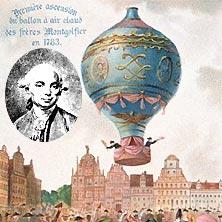
The Amazing History of Balloons
When people learned that air also has a certain weight (a liter of air weighs 1,2928 g, and a cubic meter is about 1200 g)), they came to the conclusion that almost everything that is in the air loses as much as it weighs, displacing air. Thus, an object could float in the air if the air it pushed out were heavier than it. So, thanks to Archimedes, the extraordinary history of balloons began.
The Montgolfier brothers are best known in this regard. They took advantage of the fact that warm air is lighter than cold air. A large dome was sewn from a fairly light and durable material. The ball had a hole at the bottom, under which a fire was lit, burning in a fire arranged in a boat-shaped container attached to the ball. And so the first hot air balloon took to the skies in June 1783. The brothers repeated their successful flight attempt in the presence of King Louis XVI, the court and many lesser spectators. Attached to the balloon was a cage containing several animals. The spectacle lasted only a few minutes, as the shell of the balloon was torn and, of course, it fell, but gently, and therefore no one was hurt.
The first documented attempt to use the balloon model was made in August 1709 by Bartolomeo Lourenço de Gusmão, chaplain to King John of Portugal.
In August 1783, the Robert brothers, following the instructions of Jacques Alexander Charles, thought of using another gas, more than 14 times lighter than air, called hydrogen. (It was once obtained, for example, by pouring zinc or iron with sulfuric acid). With great difficulty, they filled the balloon with hydrogen and released it without passengers. The balloon fell outside of Paris, where the populace, believing it was dealing with some kind of infernal dragon, tore it into small pieces.
Soon, balloons, mostly with hydrogen, began to be built throughout Europe and America. Air heating proved impractical, as fires often broke out. Other gases have also been tried, for example, light gas, which was used for lighting, but it is dangerous because it is poisonous and easily explodes.
Balloons quickly became an important part of many community games. They were also used by scientists to study the upper layers of the atmosphere, and even one traveler (Salomon August Andre (1854 - 1897), a Swedish engineer and explorer of the Arctic) in 1896, however, unsuccessfully, went in a balloon to discover the North Pole.
It was then that the so-called observation balloons appeared, equipped with instruments that, without human intervention, register temperature, moisture, etc. These balloons take off to great heights.
Soon, instead of the spherical shape of the balls, oblong “rings” began to be used, as the French soldiers called balls of this shape. They were also equipped with rudders. The rudder helped the balloon little, because the most important thing was the direction of the wind. However, thanks to the new device, the balloon could “deviate” a little from the direction of the wind. Engineers and mechanics thought about what to do to control the vagaries of the wind and be able to fly in any direction. One of the inventors wanted to use oars, but found out for himself that air is not water and it is impossible to row efficiently.
The intended goal was achieved only when engines powered by the combustion of gasoline were invented and used in cars and aircraft. These motors were invented by the German Daimler in 1890. Two of Daimler's compatriots wanted to use the invention to move balloons very quickly and probably without thinking. Unfortunately, the exploding gasoline ignited the gas and they both died.
This did not discourage another German, Zeppelin. In 1896, he produced the first hot air balloon, which was named the Zeppelin after him. A huge longitudinal shell, stretched over light scaffolding and equipped with rudders, lifted a large boat with motors and propellers, just like in airplanes. Zeppelins were gradually improved, especially during the First World War.
Although great strides were made in the construction of hot air balloons just before World War II, it was believed that they did not have a great future. They are expensive to build; large hangars are required for their maintenance; easily damaged; at the same time they are slow, sluggish in movements. Their many shortcomings were the cause of frequent disasters. The future belongs to airplanes, heavier-than-air devices that are carried away by a rapidly spinning propeller.
